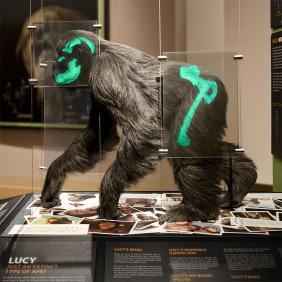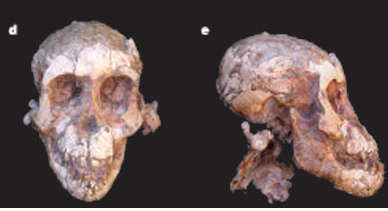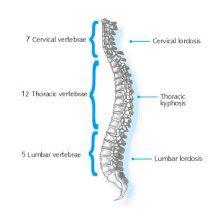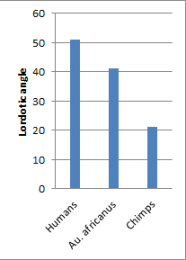Many moons ago I stumbled across Answers in Genesis’s reconstruction of the “Lucy” specimen (who belonged to the species Australopithecus afarensis, an ancestor of modern humans that lived ~3.2 million years ago). They depicted our ancestor as a four legged knuckle walker, like a chimp. This is not a reconstruction supported by the evidence and has been rejected by most of the scientific community. I wrote an article to that effect, pointing out some of the pieces of evidence that tell us Lucy actually walked upright on two legs.

The reconstruction of Lucy
Being contradicted by a lone blogger writing from the backwater that is Liverpool was too much for the multi-million dollar organisation to bare, so they wrote a rebuttal of my response. Which prompted me to write a deconstruction of their rebuttal of my response to their reconstruction. Keeping up? Alas, they continue to cite their rebuttal as the final word on the subject and have yet to acknowledge my response to it. Maybe they think that because I split my response up into multiple posts it is a different “kind” of article and so not related to their rebuttal.
So, for those who like to cram their history into 6,000 years I’ve crammed my response into this little post. The title of each section will take you to a more in depth post on the subject, if it so interests you.
#1: Creationism is science, I swears it!
An oft repeated creationist claim is that evolution and creationism are based on the same evidence, just interpreted through different worldviews. Thus they’re just as valid as each other, so anything creationists do is just as valid as anything those darn evilutionists do!

A cartoon from Answers in Genesis
In my original post I pointed out that this is far from true. Ideas are more reliable when tests and experiments vindicate them. Whilst science does a lot of hypothesis testing (the entire scientific method is built on it), creationists almost never do. Most of the “evidence” for creationism are post-dictions made after the fact, not the predictions science relies upon. As such it should not be considered on the same level as science.
AiG took issue with this claim that creationism is not on par with science, citing 2 (yes, that many) examples of creationists making predictions! Just like real scientists
The most recent and perhaps glaring example of creation scientists’ predictions are those now confirmed by the ENCODE program—the discovery that most DNA touted as “junk”…actually has function. Another example is the advance in geological understanding that resulted from plate tectonics models, first proposed by creation scientists [in 1859]
I find the reference to ENCODE particularly amusing, given that it doesn’t actually confirm that prediction. Although it claimed 80% of the genome was “functional” what they actually meant is that 80% is biologically active. This activity is not necessarily important to our survival, so could still be “junk”. As such it doesn’t confirm their prediction, a fact that other AiG writers admit (although they still find a way to claim victory on the grounds it could vindicate the prediction at some point in the future).
Which leaves us with their plate tectonic claim from 1859. I neither know, nor care, enough to find out if this is a genuine case of creationists making prediction. I’d be more than happy to concede it is, after all my claim was that most of what creationists do is post-dicting. There may be a few good apples out there doing “real” science, but that doesn’t vindicate the bad science most of them are doing.
#2: Lucy’s big hole
The foramen magnum is the hole on the base of the skull the spinal cord passes through to connect to your brain. I pointed out that the foramen magnum (Latin for big hole) of Australopithecus afarensis was located in a more human-like position, showing the spinal cord exited the skull vertically, traveling down an upright body suited for bipedalism, not knuckle walking.

A graph of the location of the foramen magnum and a diagram of its orientation (Australopithecus is the middle image)
Answers in Genesis’s response? Pointing out the skull from which the foramen magnum index was calculated was discovered in lots of pieces! That other skulls give different measurements of the foramen mangum index! That the reconstructions are not to be trusted!
We would submit that the [human-like position] of the afarensis foramen magnum occurred not deep in the evolutionary history of humanity but quite possibly sometime after 1992 in the laboratory
The other skulls they refer to have foramen magnum indices of 23% and 19%; both of which are much higher than the chimp FMI so don’t disprove what I’m saying. But then, these skulls were reconstructed and those nefarious scientists so can’t be trusted. Except AiG provide no evidence of any misdoings in the lab. It’s just handwaving talk of “oooo biases” and “oooo incomplete skull”.
Although if there are any lingering doubts about bias they can be silenced! In 2006 scientists discovered a juvenile Au. afarensis in Dikika, Ethiopia with a complete skull and attached back bone to boot! This specimen has a much more human like foramen magnum than a chimp of a comparable age, showing that Lucy did have an upright body like a human after all.

The Dikika specimen
#3: Back problems

The human spine
In my original post I claimed that Au. afarensis had the additional vertebrae in their lower back needed to produce the “kink” observed in modern humans (known as “lumbar lordosis” by fancy pants scientists). Alas, the evidence for this is not as strong as I thought. Although not disproven, the claim Lucy had the additional vertebrae is unsupported and so should be treated skeptically. I thank AiG for pointing out my mistake.
Whilst they do make this good point, they go on to make a bad one: even if Lucy did have lumbar lordosis, this would not mean she was bipedal. In support of this they point to a study that shows gorillas sometimes develop lumbar lordosis!
Their citation is to an article from 1889. Cutting edge science, eh? However, the main problem with this study isn’t it’s age but because it examined the skeleton of a juvenile gorilla and they walk upright quite often; much more frequently than adults. As the individual matures and grows larger bipedalism is no longer an efficient way to travel and they almost always knuckle walk instead. So studies of lumbar lordosis in adult gorillas have failed to find it.

Lordotic angle of some species key to this discussion
So I was wrong and so was Answers in Genesis. Where does that leave us? With me being right. Although the evidence for lumbar lordosis in Lucy is suspect we have much more firm data from her close relatives who were quite similar, like Australopithecus africanus. It turns out all the other Australopiths we have data on did have lumbar lordosis (and to a nearly human degree as well), so it’s not unreasonable to suggest Lucy did too. And that kink is evidence for bipedalism, despite what AiG think centuries old studies on gorillas say.
#4: Knuckle walking knuckles
If Lucy was a knuckle walker, you’d expect to find evidence for it in the arms and hands. Yet many studies have found that the adaptations chimps and gorillas have for knuckle walking are completely absent from Lucy and her kin, providing strong evidence AiG is wrong.
How do they dispute this compelling evidence? With my favorite paragraph in their whole article.
Evolutionists have, however, found such evidence for knuckle-walking. A more recent study by evolutionists Richmond and Strait confirms Lucy’s bones do have the features required to lock the wrist for knuckle-walking. Incidentally, this particular study is one of several plainly referenced in the Creation Museum’s Lucy exhibit.
Richmond & Strait’s study they proudly cite in their museum display argues that humans’ and chimps’ last common ancestor was a knuckle walker, as evidenced by the fact that Australopithecus afarensis retains some knuckle walking adaptations in their arms from this ancestor. Spot the problem for AiG here? This study doesn’t claim Lucy was a knuckle walker, just that she has some non-functional adaptations left over from a knuckle walking ancestor!
However, that’s assuming the research is valid and that is something which is far from certain. The analysis of Lucy revealed that her radius was similar to both gorillas and orangutans. Given that orangutans don’t knuckle walk this raises the question of whether the “knuckle walking traits” they identified are actually linked with knuckle walking. Indeed, none of them have been reliably linked to knuckle walking. For example, they claim fusion of two hand bones is “an adaptation to resist weight-bearing stresses and improve the stability of the hand in [knuckle walking].” However, subsequent research noted that there is no “evidence to support this hypothesis.“
Curiously, although Answers in Genesis are careful to note how the Richmond & Strait research is “recent” they make no reference to the even more recent research critical of the paper. Indeed, in the late 2000s multiple criticisms of the knuckle walking hypothesis were published, many of them specifically chastising Richmond & Strait’s work. Coincidentally, Answers in Genesis only cite one non-creationist article from 2006 onwards.
This is why it’s my favorite paragraph. They proudly “plainly reference” a really bad study that identifies knuckle walking traits which aren’t actually associated with knuckle walking, has been almost unanimously rejected by the scientific community and – even if it were valid - doesn’t even conclude that Lucy was a knuckle walker.
#5: Dat ass
There was a video which accompanied Answers in Genesis’ original piece on their reconstruction of Lucy in which someone claimed that the angle of Lucy’s iliac blades would’ve hampered the efficiency of the gluteal muscles, in turn preventing them from walking bipedally. Alas I failed to make a note of where one could find this video and it – along with their original article showing off the Lucy exhibit – appears to have disappeared from the site. But don’t worry, I’m not offering you a strawman of their argument. Their critique of my original post advances the exact same claim
The orientation of the iliac blades on the pelvis is a key skeletal requirement for bipedality. Notice this in the photograph of our holographic representation of Lucy and compare to those of a chimpanzee, a gorilla, and a human. The orientation of the iliac wings on the human pelvis allows the human to use gluteal muscles to counterbalance the lifting of the opposite leg during bipedal walking. This stabilizes our hips and keeps us from falling over sideways with each step. The differing orientation of ape iliac bones prevents this use of the gluteal muscles and forces apes to shift and sway from side to side when they occasionally walk upright, rendering an efficient bipedal gait skeletally impossible.
My counterpoint to this argument originally was that people have performed reconstructions of Lucy’s musculature which reveals that the gluteal muscles were in fact functional and active during bipedal locomotion. Whilst the various skeletal differences between humans and Lucy required her gluteals to expend more energy keeping us stable they did not “prevent” them from doing so as AiG claims. This lowering of efficiency meant that Lucy would’ve had to have used 3.8 joules of energy per kilogram moved per second to walk bipedally – compared to the 3.0 joules humans use – not that she was incapable of bipedalism. For contrast, children aged 8/9 also have to use 3.8 joules and they’re perfectly capable of walking upright.
Answers in Genesis rebuttal to this argument is, as you’ve seen above, to simply reiterate their original claim. They offer no justification for why we should dismiss the science showing the gluteal muscles are functional, nor do they offer any evidence for why we should accept their position that they are not (beyond the superficial “look at the ape pelvis!”). As I’ll stand by my original argument and leave it at that. After all, they clearly couldn’t fault it.
(although if you want more proof, I’ll simply say this. AiG’s “rebuttal” is based off an analysis of a hip on which it is difficult to tell where the gluteal muscles attached. Another hip bone from Lucy’s close relative, Au. africanus does contain more clear gluteal muscle markings allowing for scientists to identify where the muscles are actually located. This shows that the gluteal muscles were located in human-like positions and thus provides “favourable lever areas for the … gluteus medius & minimus for…stabilisation of the pelvis in bipedal walking).
#6: In conclusion
In short, most of creationism is unscientific, Lucy’s foramen magnum indicates she walked upright, her back probably does as well and her wrists and hip contain no evidence she was a knuckle walker or couldn’t walk upright. In other words there’s strong evidence Lucy walked upright like us. Yet she wasn’t completely human, with many ape like traits such as arms adapted for swinging through the trees and a small brain.
It’s almost as though she’s some kind of half human, half chimp…what’s the word I’m looking for….transitional form.

